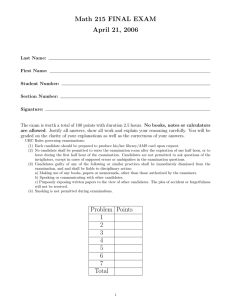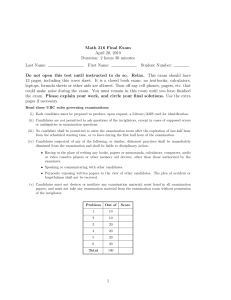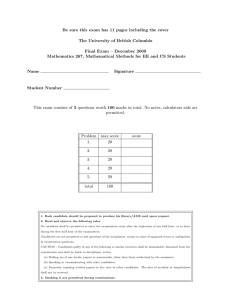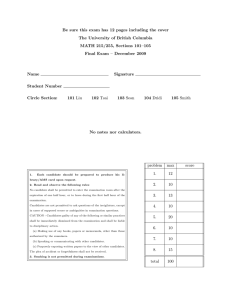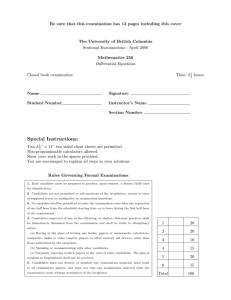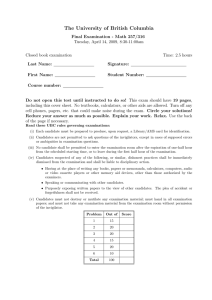April 2009 MATH 256 Name Page 2 of 11 pages
advertisement
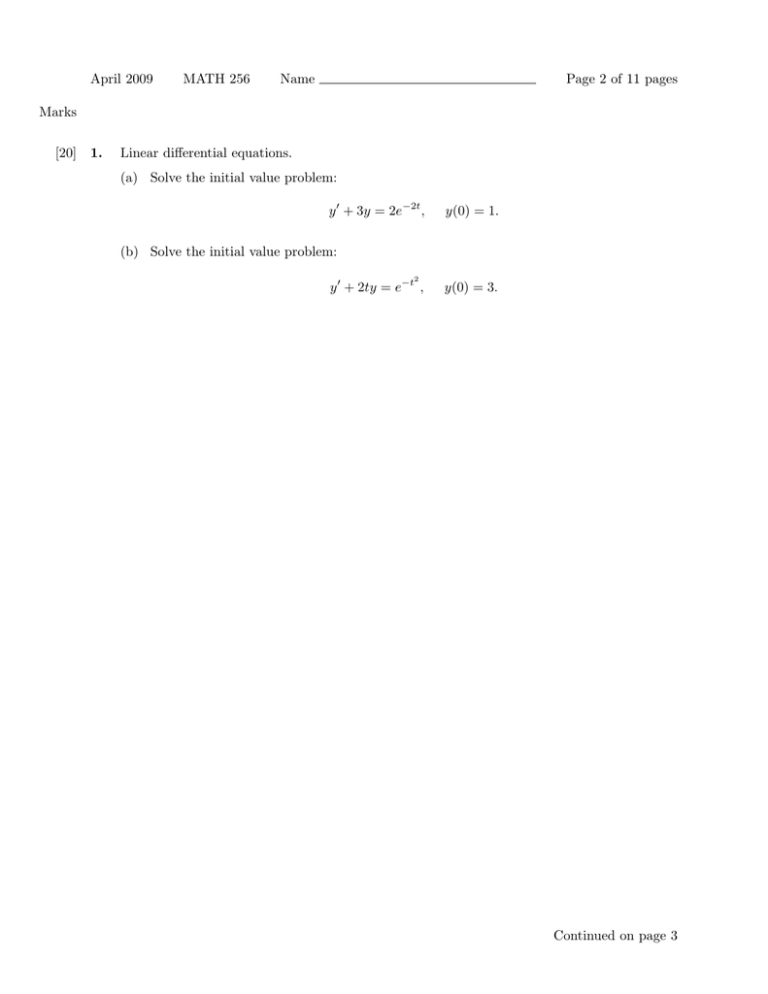
April 2009 MATH 256 Name Page 2 of 11 pages Marks [20] 1. Linear differential equations. (a) Solve the initial value problem: y 0 + 3y = 2e−2t , y(0) = 1. (b) Solve the initial value problem: 2 y 0 + 2ty = e−t , y(0) = 3. Continued on page 3 April 2009 MATH 256 Name Page 3 of 11 pages (c) Solve the initial value problem: y 00 + 2y 0 + y = 0, y(0) = 0, y 0 (0) = 2. (d) Solve the initial value problem: y 00 + 2y 0 + y = 2e−t , y(0) = 0, y 0 (0) = 0, and show that the solution y(t) has maximum value of 4e−2 . At what time is this value attained? Continued on page 4 April 2009 MATH 256 Name Page 4 of 11 pages Marks [20] 2. Find the general solution of the following homogeneous linear system: Ã x0 = 1 5 ! 3 x, 3 and sketch the phase plane close to x = 0. Continued on page 5 April 2009 MATH 256 Name Page 5 of 11 pages (b) Find the solution of the following initial value problem: Ã 1 x0 = 5 ! Ã ! 3 12t − 11 x+ , 3 −3 Ã ! 1 x(0) = . 1 Continued on page 6 April 2009 [20] 3. MATH 256 Name Page 6 of 11 pages The function f (t) is defined for t ∈ [−1, 1] by ( −t − 1, , f (t) = 1 − t, t ∈ [0, 1], t ∈ [0, 1], (a) Sketch the function f (t) over the interval t ∈ [−1, 1], and find the Fourier series for f (t). Is the function odd or even? (b) To what values should the Fourier series of part (a) converge to at: (i) t = 0.5; (ii) t = 2; (iii) t = 3; (iv) t = 3.5? Continued on page 7 April 2009 MATH 256 Name (c) Find the general solution of: Page 7 of 11 pages y 00 + ω 2 y = f (t), where f (t) is the function in part (a), assuming ω is a positive constant satisfying ω < π. (d) If instead we have ω ≥ π, for what value(s) of ω will your solution become very large as t → ∞? Continued on page 8 April 2009 [20] 4. MATH 256 Name Page 8 of 11 pages Consider the the following IBVP ut = uxx − cos 3πx, 0 < x < 1, t ≥ 0, subject to the boundary and initial conditions: ux (0, t) = 2, ux (1, t) = 2, u(x, 0) = 2x + cos πx (a) Writing u(x, t) = us (x) + v(x, t) state the problems that are satisfied by the steady state solution, us (x), and the transient solution v(x, t). (b) Find the steady state solution, us (x). Continued on page 9 April 2009 MATH 256 Name Page 9 of 11 pages (c) Find the transient solution, v(x, t) using separation of variables, and hence write down the full solution, u(x, t). (d) Show that u(0.25, t) → 1 1 + √ , as t → ∞, 2 2 and estimate how large t must be in order for ¯ ¯ ¯ ¯ ¯u(0.25, t) − 1 − √1 ¯ < 0.01. ¯ 2 2¯ Continued on page 10 April 2009 [20] 5. MATH 256 Name Page 10 of 11 pages Use separation of variables to solve the BVP: uxx + uyy = 0, 0 < x < 1, 0 < y < 1, subject to the boundary conditions: u(0, y) = 1, ux (1, y) = 0, u(x, 0) = 0, u(x, 1) = sin 5πx. Continued on page 11 April 2009 MATH 256 Name Page 11 of 11 pages The End Be sure that this examination has 11 pages including this cover The University of British Columbia Sessional Examinations - April 2009 Mathematics 256 Differential Equations Time: 2 12 hours Closed book examination Name Signature Student Number Instructor’s Name Section Number Special Instructions: Two 8 12 ” × 11” two sided cheat sheets are permitted. Non-programmable calculators allowed. Show your work in the spaces provided. You are encouraged to explain all steps in your solutions. Rules Governing Formal Examinations 1. Each candidate must be prepared to produce, upon request, a library/AMS card for identification. 2. Candidates are not permitted to ask questions of the invigilators, except in cases of supposed errors or ambiguities in examination questions. 3. No candidate shall be permitted to enter the examination room after the expiration of one half hour from the scheduled starting time, or to leave during the first half hour of the examination. 4. Candidates suspected of any of the following, or similar, dishonest practices shall be immediately dismissed from the examination and shall be liable to disciplinary action. (a) Having at the place of writing any books, papers or memoranda, calculators, computers, audio or video cassette players or other memory aid devices, other than those authorized by the examiners. (b) Speaking or communicating with other candidates. 1 20 2 20 3 20 4 20 5 20 Total 100 (c) Purposely exposing written papers to the view of other candidates. The plea of accident or forgetfulness shall not be received. 5. Candidates must not destroy or mutilate any examination material; must hand in all examination papers; and must not take any examination material from the examination room without permission of the invigilator.
